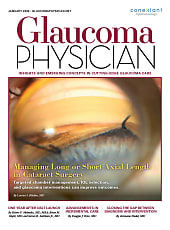IN RECENT MONTHS, THE expanding presbyopia pharmaceutical market has been quickly evolving. With the launch of Vuity (1.25% pilocarpine, Allergan), an untouched area of opportunity has opened to eyecare providers, and consumers, across the nation. In the coming years, this product will be joined by various other pharmacologic drops with the same treatment outcome of presbyopia management (see Table 1 for current studies and progress).
| AGENT/COMPANY | ACTIVE INGREDIENT(S) | LATEST CLINICAL TRIAL RESULTS | |
| FDA APPROVED | VuityAllergan/AbbVie | Pilocarpine 1.25% | GEMINI 1 & GEMINI 2
|
| PHASE 3 | CSF-1Orasis Pharmaceuticals | Pilocarpine 0.4% | NEAR-1 & NEAR-2
|
| MicroLine Eyenovia |
Pilocarpine 1% or 2% | VISION-1 & VISION-2
|
|
| PHASE 2 | BrimocholBrimochol PF Carbachol PF Visus Therapeutics |
Carbachol, Brimonidine tartrate | VIVID (3 formulations tested)
|
| Nyxol + pilocarpine Ocuphire Pharma |
Pilocarpine 0.4% Phentolamine 0.75% |
VEGA-1
|
|
| LNZ100 LNZ101 Lenz Therapeutics |
Aceclidine 1.75% | Phase 2
|
To obtain FDA approval, certain endpoints need to be met regarding near and distance visual acuity, in addition to a variety of safety considerations. Having been involved and currently actively working within research studies for similar products, I know that the study parameters and specifics don’t always mimic real life. The patient population is broader, the baseline prescription and/or health/history of refractive surgeries much more complex, and the expectations of the patients more multifaceted. What have we learned thus far about this drop and how it’s working in “real” life? In the first several months of using Vuity, here are my top tips in “real” practice.
Discuss appropriate expectations with your patient base. Whether a patient has come to you asking for this presbyopia drop or you are presenting it to them, setting expectations appropriately is very helpful to engage each patient. I educate patients that this pharmaceutical drop is going to modulate, or change, their pupil size. For my light-eyed patients, prepping them for a smaller pupil appearance is helpful so they are not concerned when noting the change. Additionally, warning of possible side effects, such as brow ache or headache, is important. The goal is to change the depth of focus temporarily, to enhance near vision without detracting from distance vision clarity. The key message here is that it seems to work differently for each patient. There are too many variables to predict with accuracy how a patient will do. I let patients know this drop could lead to freedom from glasses, reduced dependency, and/or enhanced vision with whatever main visual correction they utilize.
Set the stage for the initial trial. I instruct all my patients to try this drop for the first time when they are not going to be obliged to drive or need very precise distance or near vision clarity, until they know how their eyes “see” under the influence of the drop. I want patients to be, and feel, safe regarding their ability to perform normal activities. Some patients have found that they prefer this drop when working for extended periods on screens and/or near work. Some have found they prefer it best when heading out for dinner with friends, as long as they are not the driver. Some have found it has little to no impact on driving at all. But to be safe, proceed with caution on that first trial.
Provide continued use guidelines. I have also found that some patients, with time, adapt to the drop and find a greater range of visual flexibility after using it for a week or longer. Just like in my multifocal contact lens conversations, patients may be surprised at where they find this drop most useful in their day-to-day lives. It may not be where they expect.
Have safety discussions. I tell my patients about the origin of this drop and previous indications for glaucoma therapy and management, although this medication is at a much lower concentration than what was often used in the past. I also discuss possible risks when using it. Although all the safety criteria were met during investigational studies, that doesn’t mean there still can’t be adverse events. I warn patients regarding possible headaches, eye strain, and changes in vision. If there seems to be a very large shift in clarity, either distance or near, and even if it is temporary, they should let me know and see me in the office for evaluation. I won’t prescribe this drop to anyone who hasn’t been seen in the last 6 months for a comprehensive eye exam. I want to evaluate pupils, update vision/prescriptions, and perform a thorough retinal evaluation. Although elective, this is a drug with possible side effects, and it needs to be managed with care regarding patient use.
Use it as a launchpad. I encourage patients, regardless of outcomes with initial trials, to be ready for a variety of other options on the market. These drops, in theory, have slightly different mechanisms of action and/or delivery systems. They have the potential to give patients different possibilities in the realm of presbyopia management. Stay on the forefront, read the literature and research, and be prepared to help your patients succeed now and in the future. ■









